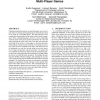105 search results - page 16 / 21 » Distributed Checkpointing Using Synchronized Clocks |
ISCAS
2006
IEEE
14 years 3 months ago
2006
IEEE
Abstract—We present a silicon neuron that uses shunting inhibition (conductance-based) with a synaptic rise-time to achieve synchrony. Synaptic rise-time promotes synchrony by de...
SRDS
1999
IEEE
14 years 1 months ago
1999
IEEE
Validating distributed systems is particularly difficult, since failures may occur due to a correlated occurrence of faults in different parts of the system. This paper describes ...
DSN
2000
IEEE
14 years 2 months ago
2000
IEEE
Distributed applications can fail in subtle ways that depend on the state of multiple parts of a system. This complicates the validation of such systems via fault injection, since...
SRDS
2000
IEEE
14 years 2 months ago
2000
IEEE
Validation of distributed systems using fault injection is difficult because of their inherent complexity, lack of a global clock, and lack of an easily accessible notion of a gl...
NETGAMES
2004
ACM
14 years 3 months ago
2004
ACM
Distributed multi-player games use dead reckoning vectors to intimate other (at a distance) participating players about the movement of any entity by a controlling player. The dea...

